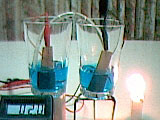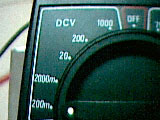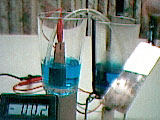


|
Temperature electrochemical battery
Science at Home |
||
|
Materials
|
Compounds
|
Videos:
download2.avi (231 KB) download3.avi (135 KB) Pictures: 



|
|
Procedure
1. Attention! During the execution of this experiment you should protect your hands with gloves and eyes with glasses. 2. Begin by setting up a saline bridge. For that follow the initial procedure of the experiment Daniell electrochemical battery. 3. Fill one glass with distilled water and pour three teaspoon of copper sulphate. Mix the solution well. 4. Pour half of the solution of copper sulphate in the other glass. 5. Using a conductive string, link the voltmeter black string (COM) to the copper electrode that will be dived in the copper sulphate solution that won't be heated up. 6. Using the other string, link the red voltmeter string to the copper electrode that will be dived in the electrolyte that will be heated. (this way you will verify that the potential sign is negative. Why?) 7. Dive the saline bridge in the copper sulphate solutions. (if the saline bridge is not well dived the system will not work) 8. Dive the copper electrodes in the respective solutions. (be careful with handling copper sulphate because it is harmful) 9. Change the voltmeter scale to milivolts. This way you will be able to verify an electric potential in the circuit. 10. Place a candle under the glass that has the copper electrode linked to the red voltmeter string. (you can verify that the potential developed by the system becomes more and more negative as the temperature of the electrolyte increases. Why?) |
||
|
Why?
As high is the energy of a metal, higher will be its trend to free electrons. The temperature increase speeds up reactions, and of course, it happens the same for the oxidation reaction (release of electrons). The negative signal of the voltmeter potential shows that the electrons flow from the heated electrode to the one that is at room temperature. This happens because the energy level of the warmed electrode is higher. On the other hand, apart from having a fastest oxidation reaction, the diffusion of ions in the electrolyte is also higher. All this factors increase the potential of the electrochemical battery. Enjoy the science at home! |
||
 |
No part of this website can be reproduced without previous authorization. Please inform me if there is any problem with the website. |